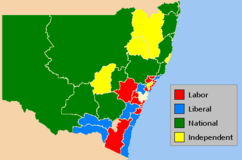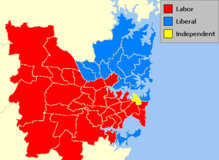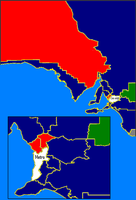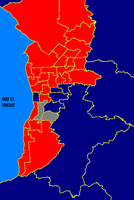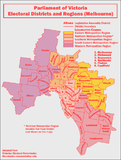
Electoral systems for the legislatures of the individual Australian states and territories are broadly similar to the electoral system used in federal elections in Australia.

The Victorian Legislative Assembly is the lower house of the bicameral Parliament of Victoria in Australia; the upper house being the Victorian Legislative Council. Both houses sit at Parliament House in Spring Street, Melbourne.

The Parliaments of the Australian states and territories are legislative bodies within the federal framework of the Commonwealth of Australia.

The New South Wales Legislative Council, often referred to as the upper house, is one of the two chambers of the parliament of the Australian state of New South Wales. The other is the Legislative Assembly. Both sit at Parliament House in the state capital, Sydney. It is normal for legislation to be first deliberated on and passed by the Legislative Assembly before being considered by the Legislative Council, which acts in the main as a house of review.

The House of Assembly, or Lower House, is one of the two chambers of the Parliament of Tasmania in Australia. The other is the Legislative Council or Upper House. It sits in Parliament House in the state capital, Hobart.

The Tasmanian Legislative Council is the upper house of the Parliament of Tasmania in Australia. It is one of the two chambers of the Parliament, the other being the House of Assembly. Both houses sit in Parliament House in the state capital, Hobart. Members of the Legislative Council are often referred to as MLCs.

Elections in Australia take place periodically to elect the legislature of the Commonwealth of Australia, as well as for each Australian state and territory and for local government councils. Elections in all jurisdictions follow similar principles, although there are minor variations between them. The elections for the Australian Parliament are held under the federal electoral system, which is uniform throughout the country, and the elections for state and territory Parliaments are held under the electoral system of each state and territory.

In Australia, electoral districts for the Australian House of Representatives are called divisions or more commonly referred to as electorates or seats. There are currently 151 single-member electorates for the Australian House of Representatives.

The Parliament of Tasmania is the bicameral legislature of the Australian state of Tasmania. It follows a Westminster-derived parliamentary system and consists of the Governor of Tasmania, the Tasmanian House of Assembly, and Tasmanian Legislative Council. Since 1841, both Houses have met in Parliament House, Hobart. The Parliament of Tasmania first met in 1856.
In Australia, one vote, one value is a democratic principle, applied in electoral laws governing redistributions of electoral divisions of the House of Representatives. The principle calls for all electoral divisions to have the same number of enrolled voters, within a specified percentage of variance. The electoral laws of the Commonwealth for the House of Representatives and all states follow the principle with some exceptions. The principle does not apply to the Senate, as each state is entitled under the constitution to the same number of senators irrespective of the population of the state.

The Western Australian Legislative Council is the upper house of the Parliament of Western Australia, a state of Australia. It is regarded as a house of review for legislation passed by the Legislative Assembly, the lower house. The two Houses of Parliament sit in Parliament House in the state capital, Perth.
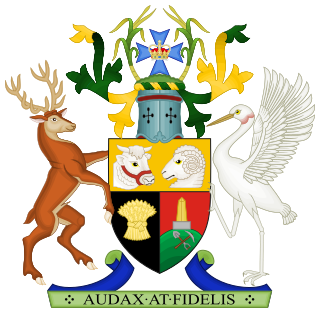
The Legislative Assembly of Queensland is the sole chamber of the unicameral Parliament of Queensland established under the Constitution of Queensland. Elections are held every four years and are done by full preferential voting. The Assembly has 93 members, who have used the letters MP after their names since 2000.
A member of the Legislative Assembly (MLA) is a representative elected by the voters of a constituency to a legislative assembly. Most often, the term refers to a subnational assembly such as that of a state, province, or territory of a country. Still, in a few instances, it refers to a national legislature.

The 1901 Australian federal election for the inaugural Parliament of Australia was held in Australia on Friday 29 March and Saturday 30 March 1901. The elections followed Federation and the establishment of the Commonwealth of Australia on 1 January 1901. All 75 seats in the Australian House of Representatives, six of which were uncontested, as well as all 36 seats in the Australian Senate, were up for election.
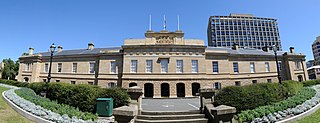
Parliament House, Hobart, located on Salamanca Place in Hobart, Tasmania, Australia, is the meeting place of the Parliament of Tasmania. The building was originally designed as a customs house but changed use in 1841 when Tasmania achieved self-government. The building served both purposes from 1841 to 1904, when the customs offices were relocated.
The following is the Australian Table of Precedence.
- The Queen of Australia: Her Majesty Queen Elizabeth II
- The Governor-General of Australia: His Excellency General the Honourable David Hurley AC, DSC, FTSE
- Governors of states in order of appointment:
- Governor of Victoria Her Excellency the Honourable Linda Dessau AC
- Governor of Western Australia His Excellency the Honourable Kim Beazley AC
- Governor of New South Wales Her Excellency the Honourable Margaret Beazley AC, QC
- Governor of Tasmania Her Excellency the Honourable Barbara Baker AC
- Governor of South Australia Her Excellency the Honourable Frances Adamson AC
- Governor of Queensland Her Excellency the Honourable Jeannette Young, PSM
- The Prime Minister: The Honourable Scott Morrison MP
- The President of the Senate and the Speaker of the House of Representatives in order of election:
- President of the Senate Senator the Honourable Slade Brockman
- Speaker of the House of Representatives The Honourable Andrew Wallace MP
- The Chief Justice of Australia: The Honourable Chief Justice Susan Kiefel AC
- Senior diplomatic posts:
- Ambassadors and High Commissioners in order of date of presentation of the Letters of Credence or Commission
- Chargés d'affaires en pied or en titre in order of date of presentation of the Letters of Credence or Commission
- Chargés d'affaires and Acting High Commissioners in order of date of assumption of duties
- Members of the Federal Executive Council:
- Ministry List
- Administrators of Territories in order of appointment:
- Administrator of Norfolk Island
- Administrator of the Australian Indian Ocean Territories
- Administrator of the Northern Territory
- The Leader of the Opposition: The Honourable Anthony Albanese MP
- Former holders of high offices:
- Former Governors-General in order of leaving office:
- The Hon. Bill Hayden AC (1989–1996)
- The Hon. Sir William Deane AC KBE QC (1996–2001)
- The Rt. Rev and Hon. Dr Peter Hollingworth AC OBE (2001–2003)
- The Hon. Dame Quentin Bryce AD CVO (2008–2014)
- General the Hon. Sir Peter Cosgrove AK CVO MC (2014–2019)
- Former Prime Ministers in order of leaving office:
- The Hon. Paul Keating (1991–1996)
- The Hon. John Howard OM AC SSI (1996–2007)
- The Hon. Kevin Rudd AC
- The Hon. Julia Gillard AC (2010–2013)
- The Hon. Tony Abbott AC (2013–2015)
- The Hon. Malcolm Turnbull AC (2015–2018)
- Former Chief Justices in order of leaving office:
- The Hon. Sir Anthony Mason AC KBE GBM QC (1987–1995)
- The Hon. Sir Gerard Brennan AC KBE GBS QC (1995–1998)
- The Hon. Murray Gleeson AC GBS QC (1998–2008)
- The Hon. Robert French AC (2008–2017)
- Premiers of states in order of state populations, then the Chief Minister of the Northern Territory:
- Premier of New South Wales
- Premier of Victoria
- Premier of Queensland
- Premier of Western Australia
- Premier of South Australia
- Premier of Tasmania
- Chief Minister of the Northern Territory
- Justices of the High Court in order of appointment:
- The Hon. Stephen Gageler AC
- The Hon. Patrick Keane AC
- The Hon. Michelle Gordon AC
- The Hon. James Edelman
- The Hon. Simon Steward
- The Hon. Jacqueline Sarah Gleeson
- Senior judges:
- Chief Justice of the Federal Court of Australia
- President of the Fair Work Commission
- Chief Justices of States in order of appointment:
- Chief Justice of New South Wales
- Chief Justice of South Australia
- Chief Justice of Tasmania
- Chief Justice of Queensland
- Chief Justice of Victoria
- Chief Justice of Western Australia
- Australian members of the Privy Council of the United Kingdom in order of appointment:
- The Rt Hon. Ian Sinclair
- The Rt Hon. Sir William Heseltine
- The Chief of the Defence Force
- Chief Judges of Federal and Territory Courts in order of appointment
- Chief Justice of the Australian Capital Territory
- Chief Justice of the Northern Territory
- Chief Justice of the Family Court of Australia
- Members of Parliament
- Judges of the Federal Court of Australia and Family Court of Australia, and Deputy presidents of the Fair Work Commission in order of appointment
- Lord Mayors of capital cities in order of city populations:
- Lord Mayor of Sydney
- Lord Mayor of Melbourne
- Lord Mayor of Brisbane
- Lord Mayor of Perth
- Lord Mayor of Adelaide
- Lord Mayor of Hobart
- Lord Mayor of Darwin
- Heads of religious communities according to the date of assuming office in Australia
- Presiding officers of State Legislatures in order of appointment, then Presiding Officer of the Northern Territory legislature:
- Speaker of the Victorian Legislative Assembly
- Speaker of the Legislative Assembly of Queensland
- President of the Victorian Legislative Council
- Speaker of the New South Wales Legislative Assembly
- President of the Tasmanian Legislative Council
- President of the South Australian Legislative Council
- Speaker of the Western Australian Legislative Assembly
- President of the New South Wales Legislative Council
- President of the Western Australian Legislative Council
- Speaker of the Tasmanian House of Assembly
- Speaker of the South Australian House of Assembly
- Speaker of the Northern Territory Legislative Assembly
- Members of State Executive Councils in order of state populations, and then members of the Northern Territory Executive Council:
- Executive Council of New South Wales
- Executive Council of Victoria
- Executive Council of Queensland
- Executive Council of Western Australia
- Executive Council of South Australia
- Executive Council of Tasmania
- Executive Council of the Northern Territory
- Leaders of the Opposition of State Legislatures in order of state populations, then in the Northern Territory:
- Leader of the Opposition of New South Wales
- Leader of the Opposition of Victoria
- Leader of the Opposition of Queensland
- Leader of the Opposition of Western Australia
- Leader of the Opposition of South Australia
- Leader of the Opposition of Tasmania
- Leader of the Opposition of the Northern Territory
- Judges of State and Territory Supreme Courts in order of appointment:
- Supreme Court of New South Wales
- Supreme Court of Victoria
- Supreme Court of Queensland
- Supreme Court of Western Australia
- Supreme Court of South Australia
- Supreme Court of Tasmania
- Supreme Court of the Northern Territory
- Members of State Legislatures in order of state populations:
- New South Wales Legislative Assembly and Legislative Council
- Victorian Legislative Assembly and Legislative Council
- Queensland Legislative Assembly
- Western Australian Legislative Assembly and Legislative Council
- South Australian House of Assembly and Legislative Council
- Tasmanian House of Assembly and Legislative Council
- Northern Territory Legislative Assembly
- The Secretaries of Departments of the Australian Public Service and their peers and the Chiefs of the Air Force, Army, and Navy and Vice Chief of the Defence Force in order of first appointment to this group:
- Vice Chief of the Defence Force
- Chief of Navy
- Chief of Army
- Chief of Air Force
- Consuls-General, Consuls and Vice-Consuls according to the date on which recognition was granted
- Members of the Australian Capital Territory Legislative Assembly
- Recipients of Decorations or Honours from the Sovereign
- Citizens of the Commonwealth of Australia

The states and territories are federated administrative divisions in Australia, ruled by regional governments that constitute the second level of governance between the federal government and local governments. States are self-governing polities with incomplete sovereignty and have their own constitutions, legislatures, departments, and certain civil authorities that administer and deliver most public policies and programmes. Territories can be autonomous and administer local policies and programmes much like the states in practice, but are still constitutionally and financially subordinate to the federal government and thus have no true sovereignty.
A political family of Australia is a family in which multiple members are involved in Australian politics, particularly electoral politics. Members may be related by blood or marriage; often several generations or multiple siblings may be involved.
Suffrage in Australia refers to the right to vote for people living in Australia, including all its six component states and territories, as well as local councils. The colonies of Australia began to grant universal male suffrage from 1856, with women's suffrage following between the 1890s and 1900s. Some jurisdictions introduced racial restrictions on voting from 1885. Such restrictions had been eradicated by the 1960s. Today, the right to vote at federal, state and local levels of government is enjoyed by citizens of Australia over the age of 18 years.

The electoral division of Clark is one of the five electorates in the Tasmanian House of Assembly, it is located in Hobart on the western shore of the River Derwent and includes the suburbs below Mount Wellington. Clark is named after Andrew Inglis Clark, a Tasmanian jurist who was the principal author of the Australian Constitution. The electorate shares its name and boundaries with the federal division of Clark.

